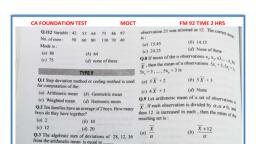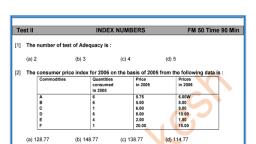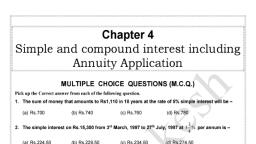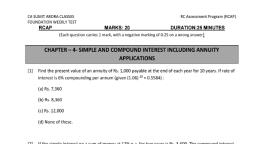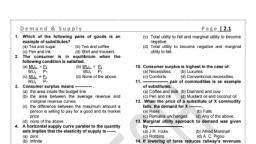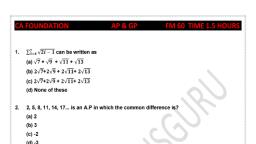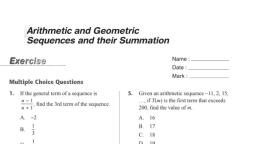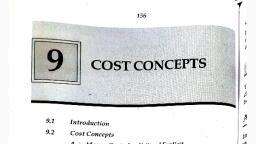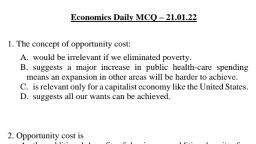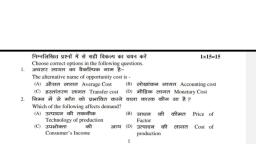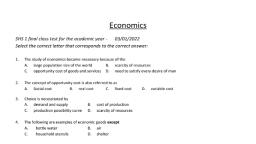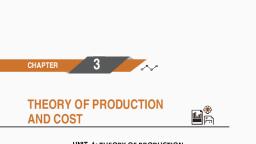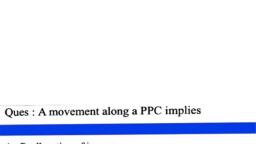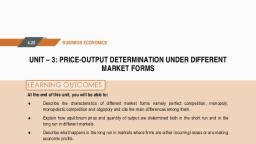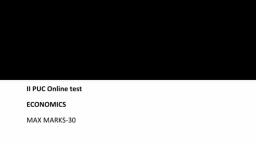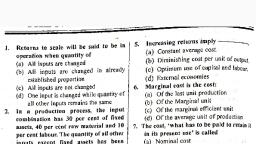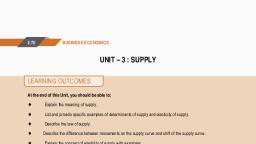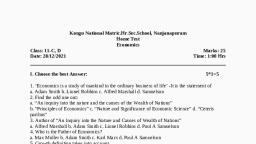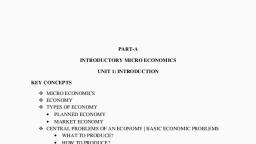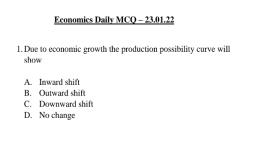Page 1 :
TOPPER’S CLASSES, , Introduction to Micro Economics Page |1.1, FM 60 TIME 1.5 Hrs, , 1. What implication does resource scarcity have for, the satisfaction of wants?, (a) Not all wants can be satisfied, (b) We will never be faced with the need to make, choices, (c) We must develop ways to decrease our, individual wants, (d) The discovery of new natural resources is, necessary to increase our ability to satisfy, wants, . Who expressed the view that “Economics should, be neutral between ends"?, (a) Robbins (b) Marshall, (c) Pigou (d) Adam Smith, . Larger production of goods would lead, to higher production in future. trade-offs? - ., (a) Consumer goods (b) Capital goods (a) Amovement from point A to point B., (c) Agricultural goods (d) Public goods . poet from point U to paint C, , (d) Point U., feed the following paragraph and answer questions Which of the following would not move the PPF, In 1940, Hitler's air force bombed Rotterdam, a for this economy Coser to point W7, beautiful city in Holland. Twenty five thousand (a) A decrease in the amount of unemployed labour, homes, 1200 factories, 69 schools and 13 hospitals roscwnces, re destroyed. Nearly 75,000 people became (b) A shift in preferences toward greater capital, , 2 formation, een JeyteGuetor 36'S of the port (c) An improvement in the overall level of, , technology, 4. The above destruction would mean: (d) An increase in the population growth rate, (a) A complete wipe off of the Production Unemployment or underemployment of one or, Possibilities Curve (PPC) of Rotterdam more resources’ ta Mustrated by production st, , (b) An outward shift of the PPC of Rotterdam a ne, (c) An inward shift of the PPC of Rotterdam ° ; aw, (9) A comnn rd movement on the same PPC of Use Table 2 to answer questions 9-14, , . If immediately after the war, Rotterdam rebuilt its | Table 2: Production Possibilities, port with the help of most up to date cranes, Production A |B |c |D E |F, docks and cargo handling technology. By the possibilities, end of the reconstruction, ships were loading [Good x Oo 641 (|2 (3 4 5, and unloading faster and at lower cost than any Good Y 30.28 (24 18 100, where in the world, It became more efficient than 9. According to Table 2, the opportunity cost of, it was before the destruction. This means: increasing Good X’s production from 2 to 4 units, (a) Rotterdam has come back to its original PPC is equal to:, (b) Rotterdam has shifted to a higher PPC (a) 10 units of ¥ (b) 14 units of ¥, , (c) Rotterdam has shifted to a lower PPC (c) 24 units of Y (d) 2 units of Y, (d) Nothing can be said . According to Table 2, the opportunity cost of, , increasing one unit of Good Y from 10 units to 18, Read the following figure and answer questions units is: ;, 6-7. (a) 3 units of X (b) 1 unit of X, , (c) 0.125 units of X (d) 0.5 units of X, , . Given the data in Table 2, as one moves from, , successively from point A to point B, C, D, E and, , F, the opportunity cost of Good X:, , (a) increases as more of good X is produced, , (b) decreases as more of good X is produced, , By Rakesh Choudhary 8468095591 / 9990709500, , , , Which of the following represents the concept of
Page 2 :
TOPPER’S CLASSES, , Introduction to Micro Economics, , FM 60, , (c) remains constant, , (d) is always equal fo one unit of Y, 12, Which of the following statements would you, , consider to be a normative one?, , (a) Faster economic growth should result if an, economy has a higher level of investment., , (b) Changing the level of interest rates is a better, way of managing the economy than using, taxation and government expenditure., , (c) Higher levels of unemployment will lead to, higher levels of inflation., , (d) The average level of growth in the economy was, faster in the 1990s than the 1980s., , 13. Consider the following and decide which, if any,, economy is without scarcity:, , (a) The pre-independence Indian economy, where, most people were farmers., , (b) A mythical economy where everybody is a, billionaire., , (c) Any economy where income is distributed, equally among its people,, , (d) None of the above, , 14, The economic analysis expects the consumer to, behave in a manner which is:, , (a) Rational, , (c) Emotional, , (b) Irrational, (d) Indifferent., , The following data give the production possibilities, frontier of an economy that produces two types of, goods, guns and bread. Read the following table and, answer questions 15-17, , | Table 1: Production Possibilities ,, Production A |B c/i/D/E |F G, possibilities, , , , , , GUNS Oo {10 |20/30/40 50 | 60, , , , , , , , , , , , , , , , | BREAD 105 [100 [90 |75| 65 |30 |o, , 15. According to Table 1, the opportunity cost of, increasing gun’s production from 20 to 30 units, is equal to, (a) 10 units of bread. (b) 15 units of bread., (c) 25 units of bread. (d) 24 units of bread., , 16. Given the data in Table 1, one moves, successively from point A to points B, C, D,E, and F, the opportunity cost of guns:, , (a) Increases as more of guns are produced,, (b) Decreases as more of guns are produced., (c) Remains constant as more of guns are, produced, (d) Nothing can be said., . Point D is efficient while point H (30 guns and 45, loaves of bread) is inefficient. Why?, , By Rakesh Choudhary, , , , Page |1.2, TIME 1.5 Hrs, , {a) Point D is outside the PPF while point H is on, the PPF., , (b) Point D is inside the PPF while point H is on the, PPF., , (c) Point D is on the PPF while point H is inside the, PPF., , (d) Nothing can be said., , . A study of how increases in the corporate, income tax rate will affect the national, unemployment rate is an example of., , (a) Macroeconomics, , (b) Descriptive economics, (c) Microeconomics, , (d) Normative economics, , |. If the marginal (additional) opportunity cost is a, constant then the PPC would be, (a) Straight line, (c) Backward leading, , (b) Convex, (d) Concave, , Figure 1 gives the production possibilities frontier of, an economy that produces two types of goods, guns, and bread. Read the figure and answer questions, 20-22, , ‘, , 20. Which point on the PPF shows a productively, efficient level of output?, (aa (b) B, (jc (d) All of the above, . Which of the following clearly represents a, movement toward greater productive efficiency?, (a) A movement from point A to point B, (b) A movement from point C to point D, (c) Amovement from point F to point C, (d) Amovement from point E to point B, 22. Which of the following illustrates a decrease in, unemployment using the PPF?, (a) Amovement down along the PPF, (b) A rightward shift of the PPF, (c) A movement from a point on the PPF to a point, inside the PPF, (d) A movement from a point inside the PPF to a, point on the PPF, , 8468095591 / 9990709500
Page 3 :
TOPPER’S CLASSES, , Introduction to Micro Economics, , FM 60, , 23. Find the correct match:, , (a) An enquiry into the nature and causes of the, ‘wealth of the nation: A.C, Pigou., , (b) Science which deals with wealth: Alfred, Marshall., , (c) Economics is the science which studies human, behaviour as a relationship between ends and, scarce means which have altermative uses:, Robbins., , (d) The range of our enquiry becomes restricted to, that part of social welfare that can be brought, directly or indirectly into relation with the, measuring rode of money: Adam Smith., , 24. From the national point of view which of the, following indicates micro approach?, , (a) Per capita income of India, , (b) Underemployment in agricultural sector., , (c) Lock out in TELCO, , (d) Total savings in India, , 25. The branch of economic theory that deals with, the problem of allocation of resources is —— —, , (a) Microeconomic theory, , (b) Macroeconomic theory, , (c) Econometrics, , (d) None of the above, , Read table 2 and answer Questions number 26-32, , , , Table 2, , , , Production Possibilities (alternatives), , , , A B Cc oD E F, , , , Hot 15 12 9 6 3 0, Pockets, , , , , , , , , , Eggos_ | 0 6 11 15 18 20, , , , 26. According to the production possibilities curve, in Table 2, a combination of 12 Hot Pockets and, 11 Eggos:, (a) is attainable and it involves an efficient use of, society's resources, (b) is attainable but involves the unemployment or, inefficient use of some of society's resources, (c) is not attainable given society's current, resources and technology, (d) may be produced only if the production, possibilities curve shifts inward, 27. According to the production possibilities curve, in Table 2, a combination of 3 Hot Pockets and, 15 Eggos:, (a) is attainable and it involves an efficient use of, society's resources, (b) is attainable but involves the unemployment or, inefficient use of some of society's resources, , By Rakesh Choudhary, , Page |13, TIME 1.5 Hrs, (c) is not attainable given society's current, resources and technology, , (d) may be produced only if the production, possibilities curve shifts imvard, , 28. Referring to Table 2, in moving from point D to, , point C, the opportunity cost of 1 more Hot, Pockets is:, , (a) 4 eggos (b) % eggos, , (c) 1 eggos (d) 4/3 eggos, , . Given the data in Table 2, as one moves, , successively from point A to points B, C, D, E,, and F the opportunity cost of eggos:, , (a) increases as more Eggos are produced, , (b) decreases as more Eggos are produced, , (c) remains constant as more Eggos are produced, (d) cannot be measured, , . Given the data in Table 2, as one moves, , successively from point F to points E, D, C, B,, , and A, the opportunity cost of Hot Pockets:, , (a) increases as more Hot potatoes are produced, , (b) decreases as more Hot potatoes are produced, , (c) remains constant as more Hot potatoes are, produced, , (d) cannot be measured, , . Which of the following would not cause an, , economy's production possibilities curve to shift, , to the right?, , (a) The discovery of new superconductivily, materials which makes manufacturing more, efficient, , (b) Adecrease in unemployment, , (c) Improvements in technology, , (d) Widespread application of irrigation to, agricultural land, , 32. In drawing a production possibilities curve,, , which of the following is (are) held constant?, , (a) The supply of natural resources and the supply, of labor., , (b) Technology and the educational attainment of, the work force., , (c) Both (a) and (b)., , (d) None of the above, , . Which of the following is not microeconomic, , subject matter?, , (a) The price of apples., , (b) The cost of producing a fire truck for the fire, department of Delhi, India, , (c) The quantity of apples produced for the apple, market., , (d) The national economy's annual rate of growth., , 34. Which of the following is a reason for the, , negative slope of the PPF?, , 8468095591 / 9990709500
Page 4 :
TOPPER’S CLASSES, , Introduction to Micro Economics, , FM 60, , (a) The inverse relationship between the use of, technology and the use of natural resources., , (b) Scarcity at any point in time we have limited, amounts of productive resources, , (c) Resource specialisation., , (d) Increasing opportunity costs., , Read table 3 and answer Questions number 35-36, With the same amount of resources, a farmer can, feed the following combinations of sheep and cows:, , , , Table 3, , , , Sheep Cows, , , , Option | 84 22, Option 75, , 35. Given the options available to him, what is the, opportunity cost to the farmer of feeding one, cow?, , (a) 1 sheep (b) 3 sheep, , (c) 9 cows. (d) 9 sheep., , 36. Given the options available to him, what is the, opportunity cost to the farmer of feeding one, sheep?, , (a) 9 sheep. (b) 3 cows., , (c) 1/3 sheep. (d) 1/3 cow,, , 37. Which of the following is correct?, , (a) Normative economics is not concemed with, value judgment., , (b) A market is a process that reconciles consumer, decision, production decisions = and, labourdecisions., , (c) A mixed economy has a certain level of, government intervention in the economy along, with private sector ownership of the economy., , (d) Both (b) and (c)., , 38, Which of the following is incorrect?, , (a) The central problem in economics is that of, allocating scarce resources in such a manner, that society's unlimited needs are satisfied as, ‘well as possible., , (b) In mixed economy, the government and the, private sector interact in solving the basic, economic questions., , (c) Microeconomics best describes the study of the, behaviour of individual agents., , (d) An important theme in economics is that market, systems are better than command (socialistic), economies, , 39. Indian economy is mixed economy because:, , (a) Agriculture and industry have both, simultaneously developed in India., , , , , , By Rakesh Choudhary, , Page |1.4, TIME 1.5 Hrs, , (b) Agriculture and industry have both developed in, the public sector., , (c) Private ownership and public ownership over, means of production co-exist., , (d) Any of the above., , Questions 40 to 42 are based on Figure 1 which, shows production possibilities curve (PPC) for, grape juice and wine., , ereeectne preeesn ire, , Crepe pomce (hires, , Figure 1, , |. The opportunity cost of increasing wine, production from D to E is:, (a) 0 litres of grape juice, (b) 5 litres of grape juice., (c) 1 litre of wine. (d) 0.2 litres of wine., , . Assuming that the PPC does not shift, which of, the following is true?, , (a) Point Ais desirable but is inefficient., , (b) Point D represents a more efficient allocation of, resources than points A and F., , (c) Point H is desirable but is not attainable., , (d) If wine production equals 7 litres, the maximum, amount of grape juice that can be produced, simultaneously is 28 litres,, , 42. The PPC in the diagram reflects:, , (a) Increasing opportunity cost of more wine, production and constant opportunity cost of, more grape juice production., , (b) Increasing opportunity cost of more wine, production and decreasing opportunity cost of, More grape juice production., , (c) Decreasing opportunity cost of more wine, production and decreasing cost of more grape, juice production., , (d) Increasing opportunity cost of more wine, production and increasing cost of more grape, juice production., , 43. Which of the following statements is correct?, , (a) In a two-good economy, the production, , possibilities frontier reflects the maximum, , 8468095591 / 9990709500
Page 5 :
TOPPER’S CLASSES, , Introduction to Micro Economics, , Page |15, , , , FM 60, , amount of one good that can be produced when, a given amount of the other good is produced., , (b) Microeconomics is the study of the behaviour of, the economy as a whole., , (c) Positive economics focuses on welfare of the, people of a society, , (d) None of the above, , 44, Which of the following statements is incorrect?, (a) Unlike normative economics, positive economics, , is based on objective analysis of economic, issues., , (b) The opportunity cost of a good is the quantity of, other goods sacrificed to get another unit of that, good., , (c) Microeconomics emphasizes interactions in th, economy as a whole., , (d) None of the above., , 45. Which of the following Is incorrect?, , (a) The production possibilities frontier shows the, maximum combination of outputs that the, economy can produce using all the resources, available., , (b) Increasing opportunity cost implies a production, possibility frontier concave to the origin., , (c) Free markets are the markets in which the, governments do not intervene., , (d) All of the above are correct., , 46. With the same amount of resources, a farmer, can feed the following combinations of goats, and horses:, , Goats Horses, , Option I 168 44, , Option tl 150 50, , Given the option available with him, what is the, , opportunity cost to the farmer of feeding one, , horse?, , (a) 1 goat. (b) 3 horses., , (c) 3 goats. (d) 18 goats., , . Which of the following involve a trade-off?, , (a) Taking a nap, , (b) All of these answers involve trade-offs., , (c) Watching a football game on Saturday aftermoon, , (d) Going to university, , 48. Trade-offs are required because wants are, unlimited and resources are ,, (a) economical. (b) unlimited, (c) efficient. (d) scarce, , . Suppose you find Rs 100. If you choose to use, , Rs.100 to go to a football match, your, , opportunity cost of going to the gameis___., , a} nothing, because you found the money., , b) Rs, 100 (because you could have used Rs, 100, to buy other things) plus the value of your time, spent at the game., , By Rakesh Choudhary, , TIME 1.5 Hrs, , c) Rs. 100 (because you could have used the Rs., 100 to buy other things) plus the value of your, time spent at the game, plus the cost of the, dinner you purchased at the game., , d) Rs. 100 (because you could have used the, Rs.100 to buy other things)., , Read Figure 1 and answer questions 50-54., Exhib:6, , 10 20 30 40 50 60 70, Ege., , 50. Refer to Figure 1, if the economy is operating at, point C, the opportunity cost of producing an, additional 15 units of bacon is, (a) 40 units of eggs. (b) 10 units of eggs, (c) 20 units of eggs. (d) 30 units of eggs., , 51. Refer to Figure 1, if the economy was operating, at E:, , (a) the opportunity cost of 20 additional units of, eggs is 10 units of bacon., , (b) the opportunity cost of 20 additional units of, eggs is 20 units of bacon., , (c) the opportunity cost of 20 additional units of, eggs is 30 units of bacon., , (d) 20 additional units of eggs can be produced with, no impact on bacon production., , 52. If the economy moves from point A to point D in, Figure 1 then:, , (a) the opportunity cost of eggs in terms of bacon, falls., , (b) the opportunity cost of eggs in terms of bacon, rises., , (c) the opportunity cost of eggs in terms of bacon is, constant., , (d) the economy becomes less efficient., , 8468095591 / 9990709500

